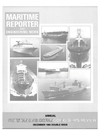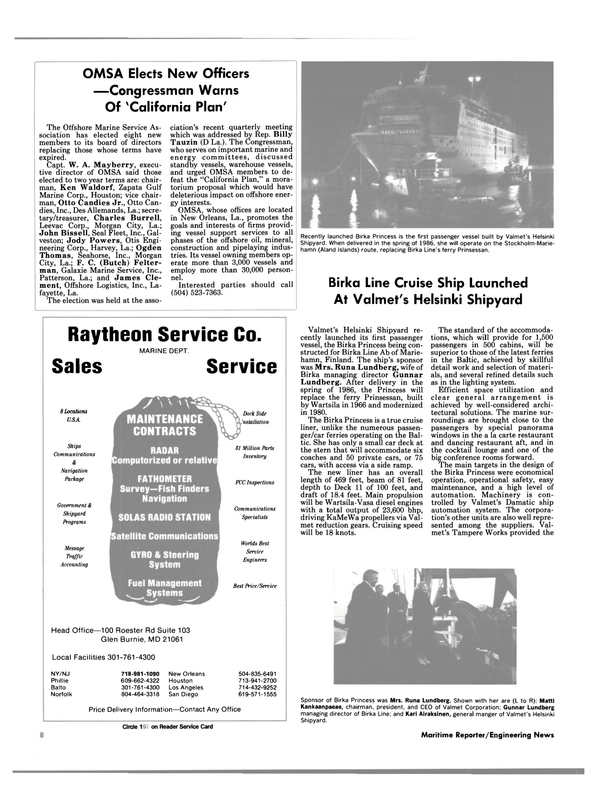
Getty Fleet Orders Lips Speed-Adapted Propellers To Increase Efficiency
—Literature Available Cognizant of the efficiencies achieved through modern propeller designs, Getty Fleet (Texaco) ordered a Lips speed-adapted propeller to meet the revised operational specifications of the M/T Getty Fleet.
The new four-blade propeller has a maximum diameter of 7,400 millimeters (24.27 feet) and an expanded area ratio of .527. Cast from Lips "Cunial" alloy (ABS Grade IV/nickel aluminum bronze) material and manufactured to ISO Class 1 standards, the finished propeller weighed approximately 62,800 pounds.
Speed-adapted propellers become a viable consideration when vessels are continually operated at lower ship speeds than they were originally designed for. It pays to exchange the propeller for a speed adapted one, designed for a new operating point. In this point the number of revolutions is lower than in the original one. Optimization of the propeller diameter now leads to a larger propeller. As a consequence of the resulting larger diameter, thrust loading coefficient is reduced, axial and rotational losses are reduced and the open water efficiency is increased. Note that the propulsive efficiency is not improved as much as the open water efficiency due to hull propeller interaction. Due to the reduced propeller load, cavitational properties will be better and an additional increase in efficiency can be obtained by reduction of blade area ratio.
For additional information, including a listing of vessels retrofitted with Lips speed-adapted propellers, Circle 51 on Reader Service Card
Read Getty Fleet Orders Lips Speed-Adapted Propellers To Increase Efficiency in Pdf, Flash or Html5 edition of December 1985 Maritime Reporter
Other stories from December 1985 issue
Content
- United States Cruises Applies To M a r A d For $150-Million Title XI page: 4
- PA Series Heavy Fuel Diesel Now Available From Fairbanks Morse page: 6
- Six-Page Color Brochure On Energol Lubricants Offered Free By BP Marine page: 6
- Getty Fleet Orders Lips Speed-Adapted Propellers To Increase Efficiency page: 6
- Karl Senner Offers Free Color Brochure On Reintjes Marine Gearboxes page: 6
- OMSA Elects New Officers —Congressman Warns Of California Plan' page: 8
- Birka Line Cruise Ship Launched At Valmet's Helsinki Shipyard page: 8
- Fire Combat, Inc. Offers 10-Page Manual On Fire Suppression Systems page: 9
- Texaco Appoints Quegan General Manager, Marine Department page: 10
- Fernstrom Elected President And CEO Of American Ship Building page: 10
- New Briefcase Computer For Marine Industry From NAV-COM page: 12
- Furuno USA Introduces New Doppler Speed Log And ARPA Line page: 12
- W. Anthony Watt Heads Sales And Marketing Division At Moran Towing page: 14
- Marinette Delivers First Of Ten Torpedo Weapons Retrievers page: 14
- Bassett Named President Of Interocean Management page: 14
- Kockums To Build Ferry With First Coal-Fired Marine Steam Engines In 30 Years page: 16
- COSCO And McMullen Form New Company— COSCO North America page: 17
- Cunard Gives $115-Million Contract To Lloyd Werft To Convert QE2 To Diesel And Alter Accommodations page: 17
- Harnischfeger To Build World's Largest Dipper/Clamshell Dredge page: 18
- Bethlehem Steel Dedicates Its New Sabine Yard In Port Arthur, Texas page: 18
- Totem To Acquire Controlling Interest In Interocean Steamship Corp. page: 20
- OUTSTANDING OCEANGOING SHIPS OF 1985 page: 22
- NOTABLE CONVERSIONS OF 1985 page: 44
- Bender Shipbuilding Wins $4.5 Million In Contracts page: 49
- Construction of 'Theodore Roosevelt' Ahead Of Schedule And Under Budget page: 50
- Magnavox Introduces New Generation SatCom And New GPS/Transit SatNav Receivers page: 51
- GPS/Transit SatNav Receivers page: 52
- Network 90, Integrated Marine Management System For Reduced Costs And Maximized Profits page: 55
- SHIPBOARD COMPUTER SURVEY page: 58
- Ellicott Machine Corporation Announces Personnel Changes page: 68
- Vapor Corporation Announces New Sphere Matrix Technology page: 68
- U.S. NAVY SHIP PROCUREMENT Second Quarterly Update—November 1985 page: 70
- MSI Conducting Tests For Proposed Canadian Ferry With Voith Schneider Propulsion page: 77
- Design Improvements In EMD's 645FB Diesel Provide Higher Horsepower, Better Fuel Economy page: 78
- Perko Presents The 200 Series International Navigation Lights page: 81
- Coast Guard Completes Installation Of Advanced Navigational Aid In N.Y. Harbor page: 85
- Macmeter Offers Metering Protection page: 91
- MARDATA Named North American Agent For Lloyd's Information Services page: 91


